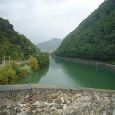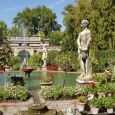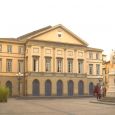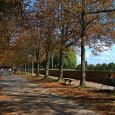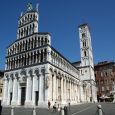Lucca
Advertisement
By Air
The airport-Tassignano Lucca, located in the municipality of Capannori is open to tourist traffic and commercial national and EU at the moment but not hosting any scheduled flights.The main international or intercontinental airport facilities closer to town so remain Florence (65 km), Pisa (30 km), Milan Malpensa (330 km) and Rome-Fiumicino (about 375 miles).
By Train
The train station in Lucca is crossed by the train Firenze-Prato-Pistoia-Lucca-Viareggio and is also the terminus of two branch lines: the Railroad and the Railroad Aulla Lucca-Pisa-Lucca. The station is only interested in regional traffic but it is a quite important and has good levels of attendance of passengers. The main train station in the province is located in Viareggio.
By Road
The main arterial road to serve the city is the Motorway A11 Firenze-Mare, which is connected by two exits, located to the east and west of the urban core.From the second source also has a branch that connects Lucca to Viareggio and quickly joins the A11 to the A12 Genoa-Rome. Another important way that touches Lucca is the National Road 12 Abetone and Brenner coming from Pisa and continues to the border with Austria, via Modena, Verona, Trento and Bolzano.
By Ferry
Lucca was a river port said up to 800 "Fiumicello" who was in the San Concordio south of the city.It allowed the Lucchese to enter into direct communication with the Tyrrhenian Sea.From the area of Fiumicello, still called the port, you could access the channel "the Ant", or "pins and needles" (width 7 meters typical) that led to the channel Ozzeri.The fact Ozzeri is a tributary to the west and east of the Serchio time it reached the Arno, through these two rivers in the past it was possible to reach the sea.The activity of the port Fiumicello stopped around 1860 with the arrival of the railroad in Lucca, faster and safer transportation.So the port was filled and there were planted with pine trees, making it more visible today.
Palazzo Pfanner
is a palace and a garden in Lucca, Italy, now converted into a museum of art and artifacts. The building dates to 1667, and is notable mainly for its fine garden, attributed to Filippo Juvarra, and an interesting external stairway with loggia.Its principal salon contains frescoes by Scorsini and De Santi (early to mid 18th century), as well as a collection of surgical instruments gathered by Dr. Pietro Pfanner (1864–1935).
National Museums of Villa Guinigi
is a museum of Lucca.The villa that houses the museum was built by Paul Guinigi, Lord of Lucca, around 1413.It was originally located just outside the walls of the thirteenth century, then it was incorporated in the subsequent expansion of the radius of the walls.The villa has a single elongated body, with airy open galleries with arches supported by columns.In 1430 the villa was purchased by the Republic of Lucca, where he was extensively modified.In 1924 the villa became the seat of the museum.After the Second World War the house was restored and restoring the original appearance.In 1968 the Museum was transformed into the National Museum.
Museum of Palazzo Mansi
It houses an important art gallery national.The Museum is located at this luxurious stable since 1965 when it became the property of the state and was completely renovated.In 1977 the National Art Gallery was inaugurated.Then the original furnishings were recovered, the frescoes and tapestries on the walls.To visit the Wedding Room with original alcove and embroidered silk fabrics of 700.The museum exhibited the works of the nineteenth century of Pompeo Batoni, Nocchi Bernardino, Stephen Tofanelli and antique textiles and tools of community life such as frames, vintage clothing patterns, religious vestments, textiles of the sixteenth, seventeenth and eighteenth century and shows a glimpse of what was the business of textile production in the territory of Lucca.
Teatro del Giglio
is a theater, the historic city of Lucca in Piazza del Giglio.In seventeenth-century origins, is named in more recent times, and especially to the dynasty of the Bourbons, the architects of the reconstruction in the nineteenth century and whose coat of arms of reported lilies's gold.It hosts an annual season of opera (which usually begins in September), a season of theater, a season of dance and a season of symphonic music.It also organizes training activities and workshops involving various initiatives aimed at the world of school, with the staging of shows for the section Theatre boys.The theater is working with the Research Centre named after Giacomo Puccini, Puccini dedicated to the realization of the project sponsored by the city of Lucca.
Serchio River Park
is a large park on the river Serchio in the province of Lucca.The river rises at an altitude of about 1000 meters from the Mount Romecchia and is about 110 kilometers long.It runs through much of the province of Lucca and reaches the Tyrrhenian Sea near Viareggio.The park creates a space for collaboration among the city of Lucca and the river over an area of 250 ettaridove you can walk, hike, bike or horseback, by canoe or kayak, but just stand along the banks enjoying of natural beauty.There are also recreational areas such as soccer fields, areas suitable for archery, a bowling, cross- model aircraft and model cars, as well as spaces for skateboarding.
Oak of the witch
is a monumental tree of Capannori in the province of Lucca.This is an example of oak (or oak) belonging to the species Quercus robur widespread throughout Europe.The witch is located in Oak Park Villa Carrara S. Martino in Colle, a village of Capannori.The mighty tree has an approximate age of 600 years.It has a height of 24 meters and a trunk circumference of 4.5 meters and a canopy of over 40 meters in diameter, measures that allow the oak to be ranked second in size in Tuscany.The peculiarity of this plant is the tendency to expand in the direction parallel to the ground, which is not common in oaks of this family.The Witches Oak is currently experiencing good condition, despite some bad adventures happened over the years.
August - November
January - April


